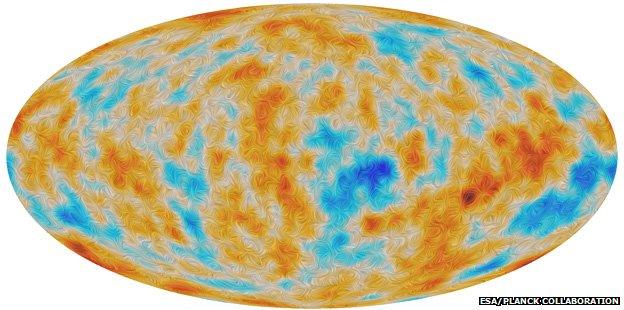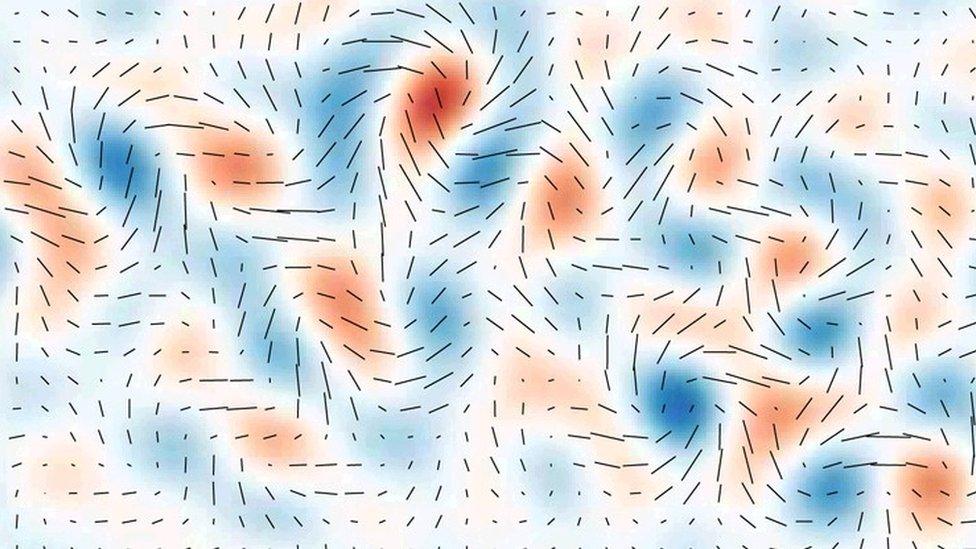Planck telescope puts new datestamp on first stars
- Published

Planck has mapped the delicate polarisation of the CMB across the entire sky
Scientists working on Europe's Planck satellite say the first stars lit up the Universe later than previously thought.
The team has made the most precise map of the "oldest light" in the cosmos.
Earlier observations of this radiation had suggested the first generation of stars were bursting into life by about 420 million years after the Big Bang.
Planck's data indicates this great ignition was well established by some 560 million years after it all began.
"This difference of 140 million years might not seem that significant in the context of the 13.8-billion-year history of the cosmos, but proportionately it's actually a very big change in our understanding of how certain key events progressed at the earliest epochs," said Prof George Efstathiou, one of the leaders of the Planck Science Collaboration.
Subtle signal
The assessment is based on studies of the "afterglow" of the Big Bang, the ancient light called the Cosmic Microwave Background (CMB), which still washes over the Earth today.
Prof George Efstathiou: "We don't need more complicated explanations"
The European Space Agency's (Esa) Planck satellite mapped this "fossil" between 2009 and 2013.
It contains a wealth of information about early conditions in the Universe, and can even be used to work out its age, shape and do an inventory of its contents.
Scientists can also probe it for very subtle "distortions" that tell them about any interactions the CMB has had on its way to us.
Forging elements
One of these would have been imprinted when the infant cosmos underwent a major environmental change known as re-ionisation.
Prof Richard McMahon: "The two sides of the bridge now join"
It is when the cooling neutral hydrogen gas that dominated the Universe in the aftermath of the Big Bang was then re-energised by the ignition of the first stars.
These hot giants would have burnt brilliant but brief lives, producing the very first heavy elements. But they would also have "fried" the neutral gas around them - ripping electrons off the hydrogen protons.
And it is the passage of the CMB through this maze of electrons and protons that would have resulted in it picking up a subtle polarisation.

Impression: The first stars would have been unwieldy behemoths that burnt brief but brilliant lives
The Planck team has now analysed this polarisation in fine detail and determined it to have been generated at 560 million years after the Big Bang.
The American satellite WMAP, which operated in the 2000s, made the previous best estimate for the peak of re-ionisation at 420 million years.
The problem with that number was that it sat at odds with Hubble Space Telescope observations of the early Universe.
Hubble could not find stars and galaxies in sufficient numbers to deliver the scale of environmental change at the time when WMAP suggested it was occurring.
Planck's new timing "effectively solves the conflict," commented Prof Richard McMahon from Cambridge University, UK.
"We had two groups of astronomers who were basically working on different sides of the problem. The Planck people came at it from the Big Bang side, while those of us who work on galaxies came at it from the 'now side'.
"It's like a bridge being built over a river. The two sides do now join where previously we had a gap," he told BBC News.
That gap had prompted scientists to invoke complicated scenarios to initiate re-ionisation, including the possibility that there might have been an even earlier population of giant stars or energetic black holes. Such solutions are no longer needed.
No-one knows the exact timing of the very first individual stars. All Planck does is tell us when large numbers of these stars had gathered into galaxies of sufficient strength to alter the cosmic environment.
By definition, this puts the ignition of the "founding stars" well before 560 million years after the Big Bang. Quite how far back in time, though, is uncertain. Perhaps, it was as early as 200 million years. It will be the job of the next generation of observatories like Hubble's successor, the James Webb Space Telescope, to try to find the answer.

Being built now: The James Webb telescope will conduct a survey of the first galaxies and their stars

The history of the Universe

Planck's CMB studies indicate the Big Bang was 13.8bn years ago
The CMB itself can be thought of as the 'afterglow' of the Big Bang
It spreads across the cosmos some 380,000 years after the Big Bang
This is when the conditions cool to make neutral hydrogen atoms
The period before the first stars is often called the 'Dark Ages'
When the first stars ignite, they 'fry' the neutral gas around them
These giants also forge the first heavy elements in big explosions
'First Light', or 'Cosmic Renaissance', is a key epoch in history

The new Planck result is contained in a raft of new papers just posted on the Esa website, external.
These papers accompany the latest data release from the satellite that can now be used by the wider scientific community, not just collaboration members.
Dr Andrew Jaffe: "The simplest models for inflation are ruled out"
Two years ago, the data dump largely concerned interpretations of the CMB based on its temperature profile. It is the CMB's polarisation features that take centre-stage this time.
It was hoped that Planck might find direct evidence in the CMB's polarisation for inflation - the super-rapid expansion of space thought to have occurred just fractions of a second after the Big Bang. This has not been possible. But all the Planck data - temperature and polarisation information - is consistent with that theory, and the precision measurements mean new, tighter constraints have been put on the likely scale of the inflation signal, which other experiments continue to chase.
What is clear from the Planck investigation is that the simplest models for how the super-rapid expansion might have worked are probably no longer tenable, suggesting some exotic physics will eventually be needed to explain it.
"We're now being pushed into a parameter space we didn't expect to be in," said collaboration scientist Dr Andrew Jaffe from Imperial College, UK. "That's OK. We like interesting physics; that's why we're physicists, so there's no problem with that. It's just we had this naïve expectation that the simplest answer would be right, and sometimes it just isn't."
Jonathan.Amos-INTERNET@bbc.co.uk and follow me on Twitter: @BBCAmos, external
- Published30 January 2015

- Published17 March 2014

- Published27 March 2013
- Published13 December 2012

- Published18 March 2013